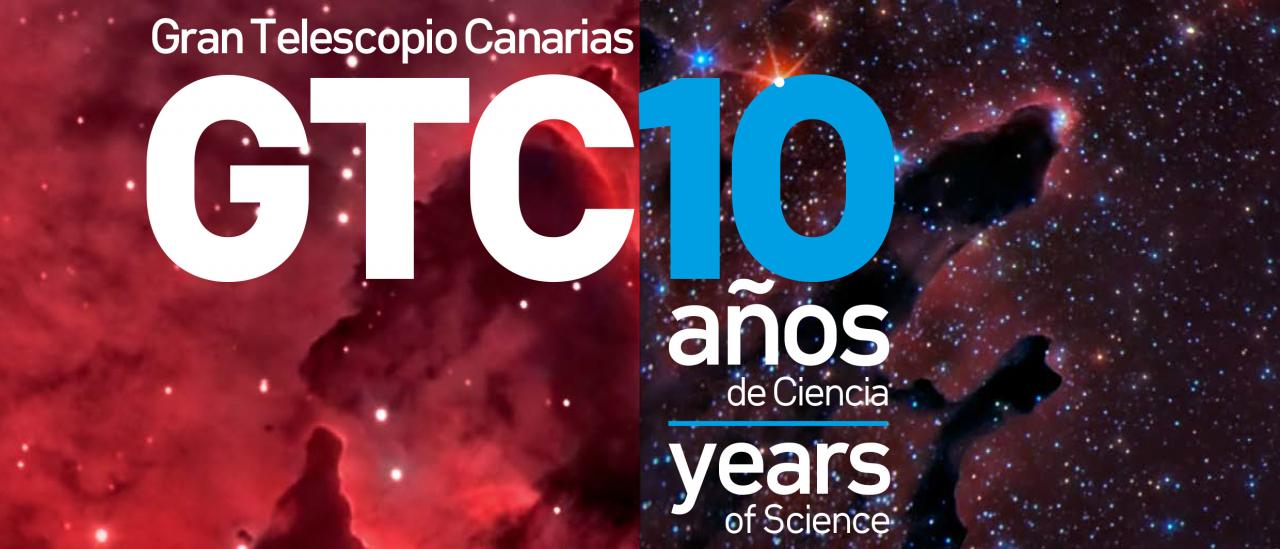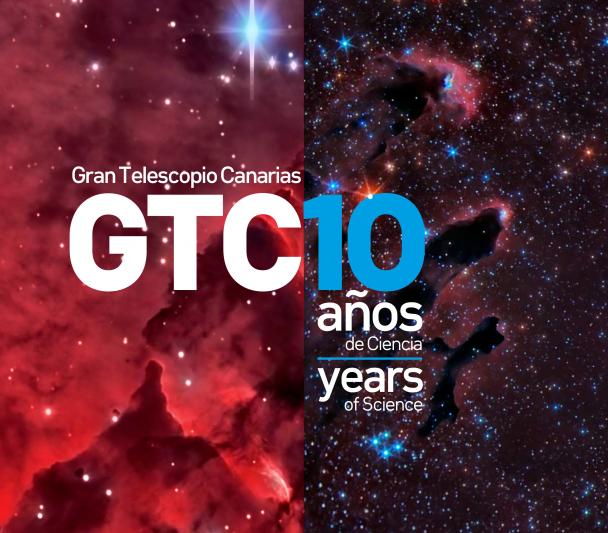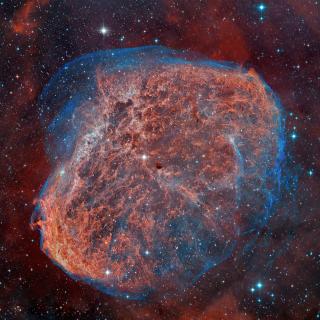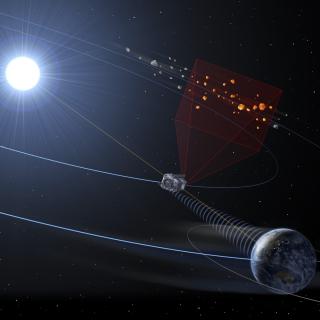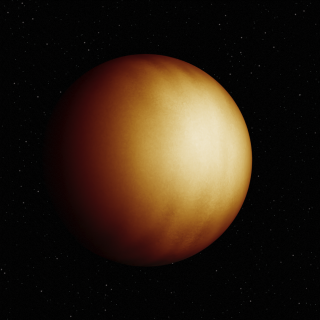The Gran Telescopio Canarias (GTC) is celebrating the tenth anniversary of its inauguration in the Roque de Los Muchachos Observatory. During the past decade the largest optical and infrared telescope in the world has carried out over 14,000 hours of observation and has produced scientific data in some 450 articles in the leading journals. Some of the key scientific highlights have been included in a special outreach leaflet recently published by the Instituto de Astrofísica de Canarias and the GTC.
On July 24th 2009 in the Roque de los Muchachos Observatory (ORM) in Garafía (La Palma) the largest and most advanced optical-infared telescope in the world was inaugurated, the Gran Telescopio Canarias (GTC) also known as Grantecan. From that day this Spanish “Big Science” infrastructure has continually shown its major capapcity and its excellent quality and scientific potential.
Thanks to the large collecting area of its primary mirror and its advanced engineering design the GTC is among the best telescopes in the world dedicated to astronomical research. Its versatile set of instruments (it currently has five instruments in simultaneous use) its highly flexible observing mode ( known as queue observing) and its extraordinary image quality (thanks to a complex system of active optics), the science produced by the GTC covers a wide range of research fields.
Until now it has carried out over 14,000 hours of observation and has produced scientific data which have given rise to some 450 articles in leading journals, “”Today” explains Romano Corradi, the director of the GTC, “the Gran Telescopio de Canarias is a highly efficient machine for producing scientific data compared to the other large telescopes in Hawaii and Chile. Its efficiency, together with the large apertura of the telescope, its sophisticated instruments and the posibility to adjust the observations according to the meteorological conditions and scientific prioriy, allows us to maximize the quantity but also the quality of the scientfic data obtained. We can say that today the Gran Telescopio Canarias is on the frontier of observational astronomy. The challenge is to maintain this privileged position for many more years”.
Promoted by the Instituto de Astrofísica de Canarias with the partipation of the National Autonomous University and the National Institute of Astrophyics, Optics and Electronics (both of Mexico) and the University of Florida (United States), the public company Grantecan S.A., founded in 1994, performed the design, contruction and mounting of the GTC. This company is currently in charge of the operation of the telescope, with a team of almost 70 full time staff to keep the telescope operational for 24 hours a day, 365 days a year.
A bit of history
The proposal to build a large telescope, more than 8 metres in diameter arose at the end of hte 1980`s with the aim of giving the Spanish astronomical community a highly competitive telescope of its own, and of giving a push to high technology in Spain. The Founding Director of the IAC, Francisco Sanchez, explains that “We had three reasons for wanting a telescope of this new type:if the ORM did not have a large telescope with the latest technology it would not remain one of the prime observatories in the world, and it would lose its strong attraction for the telescopes of the future, it was a concomitant strategic objective to give the burgeoning Spanish astrophysics its own competitive telescope, and in addition the large Spanish telescope would be a springboard for the development of advanced scientific instrumentation, with all its implications for a major impulse to innovative technology in Spain".
For many people to build this telescope was an impossible scientific-technical achievement, because Spain had never led a project of this scope. “The first thing was to see if we would be capable of doing it, and believing in oursleves” said Sanchez. This lack of confidence was also an obstacle in finding the funding. “To obtain the funds needed for such a major enterprise we needed to convince our politicians, those in the Canaries and those in Madrid, which was plagued with diffulties, nobody believed that we would really be able to build an instrument like that in Spain” recalls the Founding Director of the IAC.
However, the competitivity of the project and its economic potential finally produced the required support. Pedro Álvarez, the former Director of the GTC, picks out the contribution of Fernando Aldana, the Director of the Office of Science and Technology (OCYT for its Spanish initials) which depended on the Presidency of the Central Government, in the year 1988. “Professor Aldana, who was convinced of the capacity of the GTC as a mobilizing factor for the development of industrial technology, gave the final impulse of the project by approving the funding to goa head with it”.
With a very tight budget the National Administration and the Canary Autonomous Community funded 90% of the cost, in a ratio 70/30, using an important contribution from the European Fund for Regional Development (FEDERI. The remaining 10% was divided equally between the United States and Mexico, who each received 5% of the observing time.
The building works for the telescope starte at the ORM in the year 2,000. Over a thousand people, and around a hundred companies (over 70% Spanish) took part in the construnction, including an important fraction by companies and institutes in the Canaries. “This participation could have been greater if it had not been for the heistation and lack of support from the central government for technological preparation in the early phases of the project” explains Álvarez. “The construction of the GTC marked a turning point in the participation of Spanish industry in the construction of telescopes. Many of the companies who participated in its development are now leading, or participating in internationa projects for large telescopes”.
Finallyh the telescope had its first light in July 2007, although it did not start its scientific activity until March 2009. On July 24th 2009, ten years ago, its official inauguration was celebrated in an act with over 800 people, presided over by Their Majesties the King and Queen of Spain, at that time Juan Carlos 1 and Sofía, and with the presence of important political authorities and of representatives of the institutions involved with the contruction of the GTC.
Frontier Science
In its first 10 years of observation the GTC has allowed us to observe the universe as never before. There is almost no type of astronomical objects that the GTC has not explored with its observations: extrasolar planets, evolved stars, black holes, primtive stars, magnetic fields in the centre of the Galaxy, faint galaxies, dark matter, gravitational lenses, and highly energetic explosive events among others.
“The results obtained with the GTC” says Rafael Rebolo, Director of the IAC, “are exceptional, not only for the quantity of data obtained and of scientific articles published, but also for their quality and impact. In the objective to carry out frontier science we can pick out certain observations which have required such exceptional performance that they have taken the GTC to its limit. A good example of this was the detection of the galaxy UG00180, at a distance of 500 million light years, whose images are the deepest taken of any galaxy from the ground".
Some of the achievements of the GTC in these 10 years have been colelcted in a special outreach leaflet which has just been published. In fact outreach, and communication to society of the scientific discoveries and technological advances are a part of the mission of the GTC. Press releases, lectures, workshops, conferences, exhibitions etc. are some of the actions which the GTC has carried out from the beginning. Also we facilitate and promote guided visits to the telescope: in 2019 we expect over 10,00 visitors to the GTC. It also plays a major role in our educational programme “Our students and the ORM” in which, every year, there is participation by over 700 secondary school students in La Palma, and we favour visiting stays by school students and by young graduates in astronomy and the technical sciences.
Promising future
In 2022 the present planned instrumentation for the GTC should be complete, with seven scientific instruments occupying the focal stations of the telescope. A call for the next generation of instruments has been sent out, and these should guarantee the scientific competitivity of the instrument during the coming years, taking into account that the GTC will continue to be the largest working optical-infrared telescope until 2027., when the next generation of very large telescopes with start operation.
As well as the instruments, another important step forward will be the installation of a system of adaptive optics (GTCAO) which should compensate the atmospheric turbulence in the field of view, which should work in the near infrared-GTCAO will start operating with a natural guide star system, and a couple of years later with a laser guide star system.
The Gran Telescopio Canarias is part of the network of Singular Scientific and Technical Infrastructures (ICTS) of Spain.
More information
Leaflet “ Gran Telescopio Canarias : 10 años de Ciencia” (issuu)
Video "Grantecan 10 años al límite del Universo"
Contact:
Romano Corradi, director del GTC: romano.corradi [at] gtc.iac.es (romano[dot]corradi[at]gtc[dot]iac[dot]es)
Antonio Cabrera, jefe de operaciones científicas del GTC: antonio.cabrera [at] gtc.iac.es (antonio[dot]cabrera[at]gtc[dot]iac[dot]es)
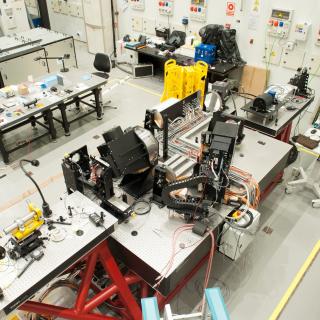
The Adaptive Optics (AO) for the Gran Telescopio Canarias (GTC) corrects the effect of the atmospheric turbulence on the light, to exploit the high spatial resolution capability of GTC. The Laser Guide Star (LGS) extends the coverage of GTCAO to any part of the sky, increasing dramatically the capability to do high spatial resolution science.
